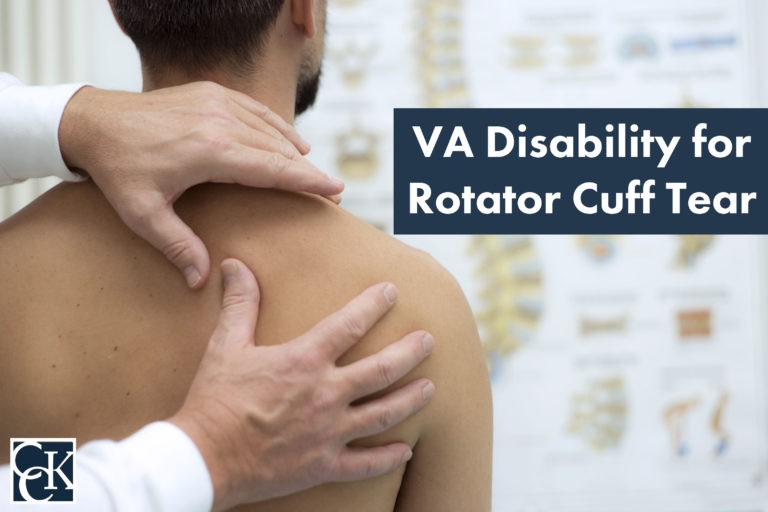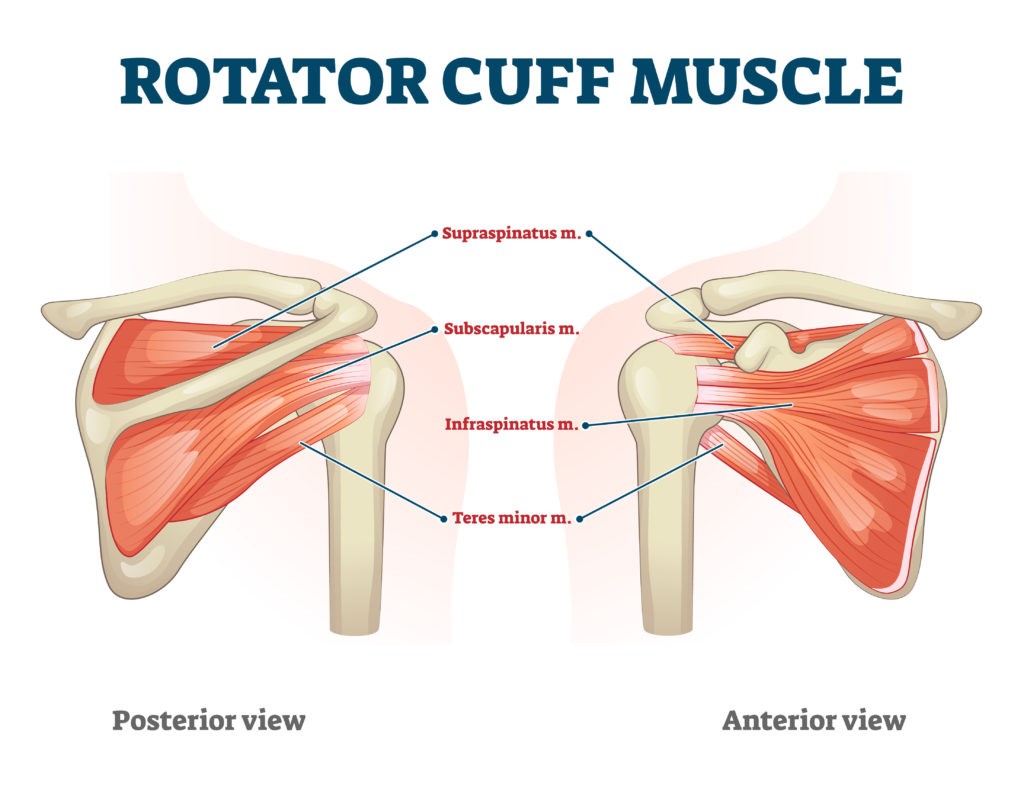VA Disability Rating for Shoulder Rotator Cuff Tear

CCK Law: Our Vital Role in Veterans Law
What is a Rotator Cuff Tear?
A rotator cuff tear is one of the most common injuries related to the rotator cuff. The rotator cuff is made up of muscles and tendons that keep the head of the upper arm bone (i.e., humerus) firmly within the socket of the shoulder. Each of the following are muscles contained in the rotator cuff:
- Supraspinatus – holds the humerus in place and keeps the upper arm stable; helps lift arm
- Infraspinatus – main muscle that allows for rotation and extension of shoulder
- Teres minor – the smallest rotator cuff muscle that assists with rotation of the arm away from the body
- Subscapularis – holds the upper arm bone to the shoulder blade and helps arm rotation
Most often, a rotator cuff tear is the result of wear and tear from daily use. Individuals are more likely to suffer a rotator cuff tear if they engage in certain repetitive motions (e.g., overhead motions). Nonetheless, some rotator cuff tears may occur as a result of a single injury. Pain is the most common symptom associated with rotator cuff tears. The pain may:
- Be described as a dull ache deep in the shoulder
- Disturb sleep
- Make it difficult to comb hair or reach behind the back
- Be accompanied by arm weakness
All of the above-mentioned symptoms can range in terms of severity. Specifically, some individuals with rotator cuff tears may be able to complete their regular, day-to-day activities while others may be unable to perform daily tasks.
Diagnosis
Again, rotator cuff tears may be the result of either a substantial injury to the shoulder or progressive degeneration of the tendon tissue. Progressive degeneration may be caused by repetitive overhead activity or heavy lifting over a prolonged period of time. Other risk factors for rotator cuff tears include age and family history. If rotator cuff tears are not treated properly, individuals are at risk for permanent loss of motion or weakness and further degeneration of the shoulder joint.
To diagnose a rotator cuff tear, doctors will press on different parts of the shoulder and move the arm into different positions. Furthermore, the examiner will likely test the strength of the muscles around the shoulder and in the arms. In some cases, imaging tests, such as X-rays, ultrasounds, and MRIs, may be required for proper diagnosis.
Treatment
There are various treatment options related to rotator cuff tears. Conservative treatments consist of at-home remedies such as rest, ice, and over-the-counter pain medications. If these treatments do not improve the pain associated with the rotator cuff tear, other treatment options may be warranted. For example, a doctor may recommend a steroid injection into the shoulder joint, especially if the pain is interfering with sleep and/or daily activities.
Physical therapy is also a viable option as it involves exercises tailored to the specific location of the rotator cuff injury. The goal of physical therapy for rotator cuff tears is to restore flexibility and strength to the shoulder and surrounding arm muscles. If the rotator cuff injury is severe, surgery may be required. There are many types of surgeries available for rotator cuff tears, including the following:
- Arthroscopic tendon repair
- Open tendon repair
- Tendon transfer
- Shoulder replacement
However, surgery is usually reserved for the most extreme cases in which individuals are unable to function with the injury.
Veterans and Rotator Cuff Tears
Injuries to the shoulder, including rotator cuff tears, commonly occur while performing both combat and non-combat duties during service. While serving, veterans were often tasked with heavy lifting and training exercises that involved overhead motions. Completing these tasks over a long period of time while serving may contribute to subsequent shoulder injuries.
Additionally, if a veteran experienced a traumatic injury while in service, it is possible that a rotator cuff injury occurred as a result. If veterans believe their rotator cuff tears or shoulder injuries are due to their active duty military service, they may be eligible for service connection.

Service Connection for Rotator Cuff Tears
Direct Service Connection
To establish direct service connection for a rotator cuff tear, veterans must demonstrate the following: (1) a current diagnosis of a rotator cuff tear; (2) an in-service event, injury, or illness; and (3) a medical nexus linking the current, diagnosed rotator cuff tear to the in-service event, injury, or illness. Once service connection is granted, VA will assign a disability rating based on the severity of the veteran’s condition.
Secondary Service Connection
In some cases, secondary service connection may be warranted for rotator cuff tears. Specifically, if veterans suffer a rotator cuff tear as a result of a service-connected condition, they can apply for VA disability benefits. For example, a veteran is service-connected for degenerative arthritis in the shoulder, which leads to a weakening of the shoulder joint and associated muscles. The muscle weakness then causes a rotator cuff tear.
In this case, the veteran can argue that their service-connected degenerative arthritis of the shoulder caused the rotator cuff tear. If they can provide a medical opinion demonstrating that causal relationship, secondary service connection will likely be awarded.
How Does VA Rate Rotator Cuff Tears?
Generally speaking, VA rates shoulder and arm conditions under both 38 CFR § 4.71a – Schedule of Ratings, Musculoskeletal System and § 4.73 – Schedule of Ratings, Muscle Injuries. A veteran’s rotator cuff tear and residual injuries may be rated according to the following Diagnostic Codes:
Diagnostic Code 5200 – Scapulohumeral articulation, ankylosis (abnormal stiffening and immobility) of:
- 50% (major) / 40% (minor) – unfavorable, abduction limited to 25 degrees from side
- 40 / 30% – intermediate between favorable and unfavorable
- 30 / 20% – favorable, abduction to 60 degrees, can reach mouth and head
Diagnostic Code 5201 – Arm, limitation of motion of:
- 40 / 30% – to 25 degrees from side
- 30 / 20% – midway between side and shoulder level
- 20 / 20% – at shoulder level
The Diagnostic Codes under 38 CFR § 4.73 for shoulder and arm conditions are split into six groups based on the limitation of motion of the different affected muscles. All of the criteria include severe, moderately severe, moderate, or slight and correspond to a disability rating ranging from 0 to 40 percent. The disability rating assigned also depends on whether the veteran’s dominant (higher evaluation) versus nondominant (lower evaluation) shoulder/arm is affected.
Rotator cuff surgery is rated based on the severity of the pain and the thickness of the rotator cuff tear. Most often, VA rates this condition as 10 or 20 percent disabling. If shoulder replacement surgery takes place, a higher rating may be warranted.
TDIU for Rotator Cuff Tear
Veterans with service-connected rotator cuff tears may be eligible for total disability based on individual unemployability (TDIU) if their condition prevents them from working. That is, if veterans cannot carry out the functions of their job due to the rotator cuff tear and therefore, are unable to secure and maintain substantially gainful employment, TDIU benefits may be awarded.
Was Your VA Claim Denied?
The skilled team at Chisholm Chisholm & Kilpatrick LTD has years of experience successfully representing Veterans before the Department of Veterans Affairs and the Court of Appeals for Veterans Claims. Contact us for a free consultation today at 800-544-9144.
About the Author
Share this Post

